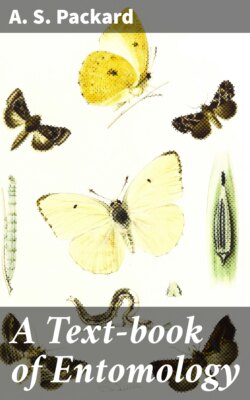Читать книгу A Text-book of Entomology - A. S. Packard - Страница 10
На сайте Литреса книга снята с продажи.
INSECTA (HEXAPODA)
ОглавлениеTable of Contents
We are now prepared to discuss the fundamental or essential characters of the insects, including the wingless subclass (Synaptera), and the winged (Pterygota).
Diagnostic characters of insects.—Body consisting of not more than twenty-one segments, which are usually heteronomous or of unequal size and shape, arranged in three usually well-defined regions; i.e. a head, thorax, and hind-body or abdomen. Head small and flattened or rounded, composed of not less than six segments, and bearing, besides the eyes, at least four pairs of jointed appendages; i.e. one pair of antennæ, and three pairs of masticatory appendages, the distal or molar portion of which is primarily divided into three divisions, supported on a stipes and cardo, and in certain orders modified into piercing or sucking structures. The head is composed of an epicranium, bearing a distinct clypeus and labrum, with the epipharynx. Mandibles 1–jointed, without a palpus and very generally with no, or uncertain, traces of a lacinia and a stipes. Two pairs of maxillæ; the first pair separate, usually 3–lobed, comprising a lacinia, galea, and palpifer, with a palpus which is never more than 6–jointed. The second pair united to form the labium or under lip, composed of two laciniæ fused together; in the generalized forms with a rudimentary galea; bearing a pair of palpi, never more than 4–jointed; with paraglossæ sometimes present.
(A third pair of mouth-appendages situated between the antennæ and mandibles in the embryo of Anurida, and Apis, and adult Campodea.)
The epipharynx forming the roof of the mouth, and bearing gustatory organs. Hypopharynx usually well developed, lying on the under side of the mouth, just above the labium, and receiving the end of the salivary duct.
Eyes of two kinds: a pair of compound, and from two to three simple eyes (ocelli).
The thorax consisting of three segments, the two latter segments in the winged orders highly differentiated into numerous tergal and lateral pieces and a single sternum; in the Synaptera the segments are undivided. (In the higher Hymenoptera the basal abdominal segment coalesced with the thorax.) Three pairs of legs, each foot ending in a pair of claws. Two pairs of wings (except in the Synaptera), a pair to each of the two hinder thoracic segments; the wings occasionally reduced or wanting in certain adaptive forms, which, however, had winged ancestors.
Abdomen consisting at the most of from ten to twelve segments. No functional abdominal legs except in the Thysanura, and in the larvæ of Lepidoptera. A pair of 1– or many-jointed cercopods on the tenth segment; and in certain forms a pair of styles on the ninth segment. In certain orders an ovipositor or sting formed of three pairs of styliform processes; in Collembola a single pair of processes forming the elater.
The genital openings opisthogoneate, usually single, but paired in Thysanura (Lepisma), Dermaptera, and Plectoptera (Ephemeridæ).
The digestive canal in the winged orders is highly differentiated, the fore-intestine being divided into an œsophagus and proventriculus, the hind-intestine into an ileum, colon, and rectum, with rectal glands.
The nervous system consists of a well-developed brain, in the more specialized orders highly complicated; no more than thirteen pairs of ganglia, which may be more or less fused in the more specialized orders. Three frontal ganglia, and a well-developed, sympathetic system present.
Stigmata confined (except possibly in Sminthurus) to the thorax and abdomen, not more than ten pairs in all, and usually but nine pairs. Tracheal system as a rule highly differentiated; invariably with tænidia.
Dorsal vessel with ostia and valvules; no arteries except the cephalic aorta; no veins. After birth there is in the more specialized pterygote orders a reduction in the number of terminal segments of the abdomen.
Development either direct (Synaptera), or with an incomplete (with nymph and winged or imaginal stages), or complete metamorphosis; in the latter case with a larval, pupal, and imago stage.
The insects may be divided into two sub-classes,—the Synaptera, and the winged orders, Pterygota, of Gegenbaur (1877), since the differences between the two groups appear on the whole to be of more than ordinal rank.
